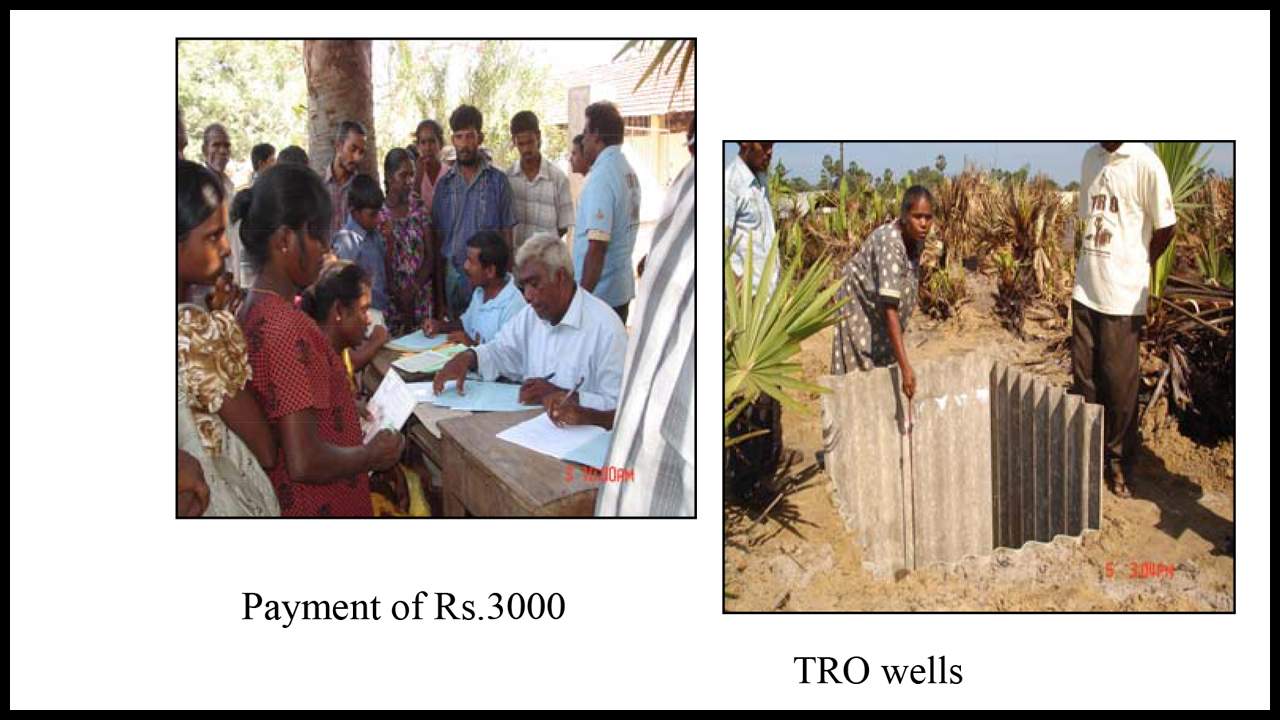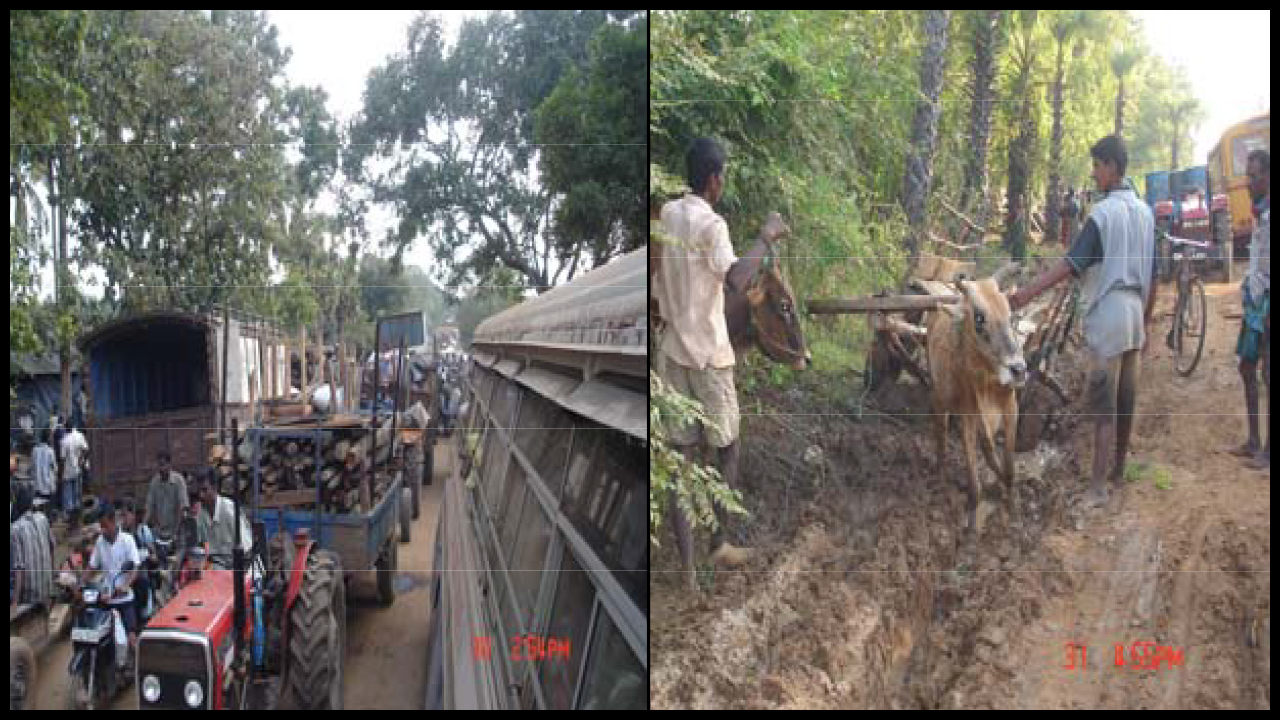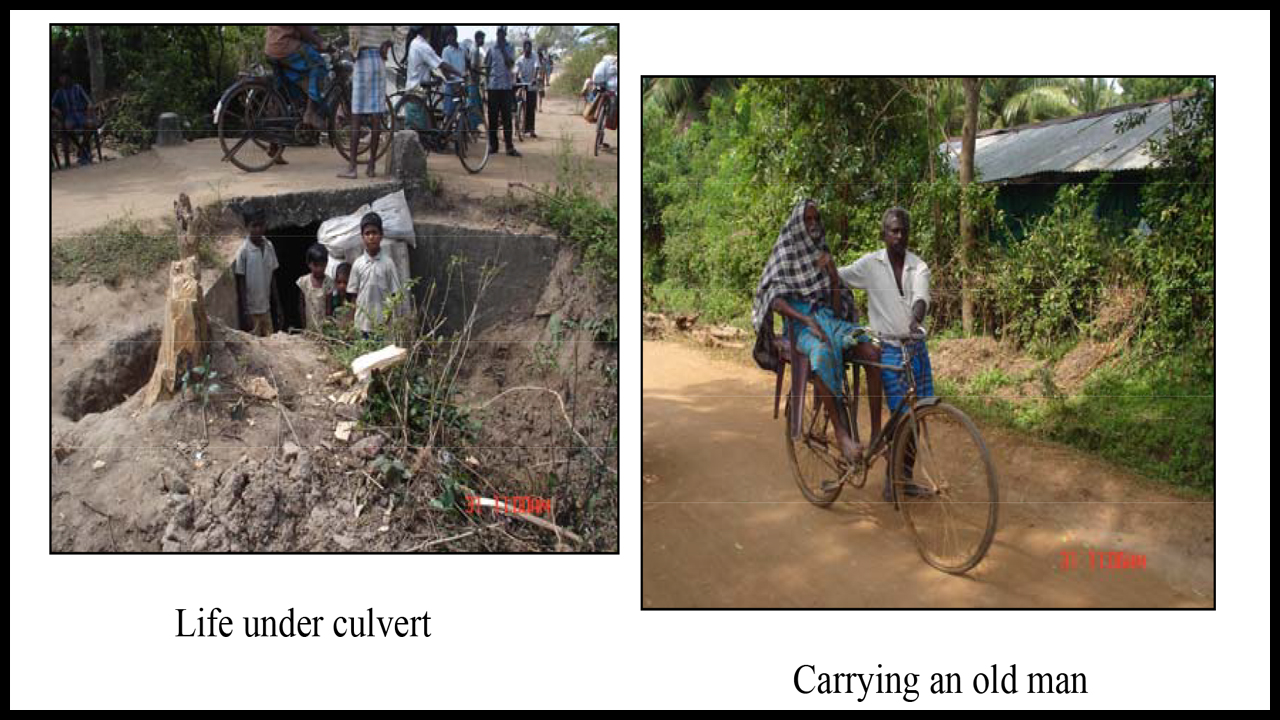On the Spot Report – Bunker life: By Lawrence Christy, Planning Director, TRO
Updated on 11th March, 2009.
At any time shell may fall amidst you and your family. With screeching sound one sole shell will pass us and fall somewhere close by. It will fall with devastating effect. No one will expect this treacherous shell. You will be sleeping in your shelter. You may be on the road buying something. Children may be playing. Some may be having bath. That shell will fall among the crowded refugee population. Six or seven will fall dead. Scores will
get injured.
From this first shell no one knows how to escape. Before second shell falls all will be in the bunkers. Like parent rabbits and their kids scurrying to a hole when they saw a vulture parents dragging and lifting their children and hurry into the bunkers. After that, about 10 – 15 shells will fall in quick succession around the area. After that there will be a pause. They will come out and get into their usual chores. Again in half or one hour’s time suddenly without any warning shells will start falling causing casualties. This is the daily
occurrence. It takes the toll of about 70 – 80 deaths and hundreds injured everyday This has become a routine – a way of life. Horror filled atmosphere. Waiting in anticipation of death with fear all over the body. Expecting the visit of Kaalan – god of time and death.
A shell may fly directly into a bunker. It may fall on the bunker destroying the Palmyra logs and kill some people inside the bunker. It may fall at the entrance of a bunker and the shell fragments may kill and injure some in a bunker. This has happened in many places. A shell has just gone into the bunker through the entrance killing 5 people inside. People will say, “please take cover inside the bunker. that’s safe. If a shell falls on a
bunker that’s his/her Kaalam – time has come – no one can prevent his/her death.”
People spend most of the time in a bunker in a day. They sleep at nights inside the fortified spacious bunker with children. They make bunkers inside the shelter or around their shelters. Some sleep at nights inside their shelters and when shelling starts immediately rushes into the bunkers. These are the people getting killed when first shell falls on their shelters. These bunkers are I or L shape narrow open bunkers. All family members can not sleep inside. All can not afford to build fortified bunkers. They are fortified with sand bags and Palmyrah logs. It cost about 10,000 rupees. For each log we have to pay Rs.300.00. We need at least 15 logs to have a bunker that houses a family. Rs. 4,500.00. Transport Rs.4000.00 for two journeys in a tractor. For making a bunker we have to spend Rs.2,000.00.
When shelling starts at nights you cannot sleep. This will continue for 2 or 3 hours. You have to listen to the sound of firing the shell. From that you can judge whether it will fall close to you or far away. Then you have to watch the direction and range of the shell. If it passes over you and falls near by you have to be more alert. Even inside the bunker you have to lie low. If the shells falls around your shelter – very close by you can not do anything. Just keep your eyes shut hoping that the shell won’t fall just on our bunker killing and injuring all of us inside the bunker. At that time women and old people will normally start praying and calling the names of all gods.
In two occasions shells knocked the heads of a man and a woman killing both instantly but they didn’t explode. In one incident a shell wiped out a whole family of 5 members. It hauled up the mangled body of a 14 year old girl into a big tree. A girl of about 16 years has lost her right leg. She was walking with the help of crutches. We met her in the hospital. Doctor has authorized her to be taken by ship to Trincomalee. She was about to leave. Her friend was bidding “Good bye” to her. She told her amputee friend, “Long live with crutches.
Artillery pieces are area weapons – they wipe out a certain area. Artillery shells fall with terrifying sound and flash of light. If 2 or 3 artilleries are coordinated 2 or 3 shells will fall in seconds gap and around a small area. Multi barrel guns cause severe damages to men and properties by destroying a vast area. Cluster bombs
explodes at a distance in the air and scatter 10 – 20 grenade size small bombs which explode when touch the ground. 81 mm mortar shell – people call 5 inch shell will fall suddenly – we can not hear the sound of the firing and it falls before we take any precaution. Napalm bombs some times fired. They burn out a substantial area. It blackens human body and makes it as a charcoal. It blazes human face beyond recognition. Some
weapons are internationally banned. Cluster bombs and napalm bombs come under such category of weapons.
Shelter: No standards are adhered. No space, no timber and no cadjan available to enforce standards. People could snatch tarpaulin sheets and escape from falling shells and racing bullets. A small area from Maththlan to Mulliwaikal contains over 300,000 population. People put up shelters when they find a space enough for a tarpaulin sheet. Shelters are too close to each other. In between bunkers have to be built. Living under the tarpaulin sheet is unbearable. It’s like sitting inside an oven. The area where IDPs are staying has few trees. The season is too hot in the day – the sun is scorching. The sandy land reflects the heat and increases the heat manifold. We can not walk even wearing slippers. The toes sink deep into the hot sand which smolder the toe
tips. No where to go looking for shade. They suffer under the heating sun. Water and Sanitation: Most of the under ground water table in this area is salty. Close to the beach you can find
drinking water. People themselves dig holes and get water. some use oil barrels – some use carved Palmyra trunk for well wall. TRO uses 4 asbestos sheets interred into the sand. Some wells are used for drinking purpose only. Others are for washing and bathing. Drinking water is not enough for the consumption of the whole
population. Pradesiya saba with the help of Solidar and Oxfam provides bowser water directly or pumping into 2000 litre water tanks. There will be a long queue to get this water.
The queue snakes down for half a kilo metre. The people keep their pots and cans early in the morning in a long line before the arrival of the bowser. When bowser arrives the queue moves in an orderly manner to the water. Disposal of waste water is a problem. Water management committees are formed for managing economic water usage and channeling waste water to elsewhere from the well area.
Sanitation: Most of the people use the open beach and shrubby forest area for toileting. Some use hoes for digging small instant pits – many just go without hoes. Bad smells were everywhere – beach and the forest have become a dirty place with human waste. This has led to the increase of flies in multitude. This would definitely lead to the spread of diarrhea and other epidemic. Some have put water seal toilets. Pit toilets cannot be built
within the settlements.
Counter measures:
? Home visit and group discussion on health habits by health volunteers under PHI and PHM.
? Construction of 30 pit toilets by TRO near the shrubby forest area away from IDP settlements.
? Fishemen’s Cooperative Federations has built additional 1000 toilets on coastline with cadjan closet
and tin sheet canal taking the waste into the sea. This canals will be washed by natural waves.
? Dissemination of information on health matters by loud speakers and hand bills
Diseases: Chickenpox, diarrhea, viral fever, sore eyes and cough etc. are widespread. Cough is common to most of the IDPs. At nights from almost every shelter you can hear the terrible sound of coughing. The viral fever repeating several times. The atmosphere is such. People are living in close proximity. Many are suffering from viral fever. With weak body you get this fever repeatedly.
With the shortage of anti biotics, anesthesia and pethadin that helps in the su rgery and aftermath people prefer getting killed to getting wounded. The pain during the amputations and the wounds getting puss without anti biotic and the non availability of drugs dragging the healing of a wound are matters which make life unbearable. Amputations are taking place without anesthesia. Operation theatre is like a slaughter house with pool of blood. With screaming and shrieking voices it becomes a torture chamber. Dead are the blessed who will not suffer.
Food and famine: Famine is spreading fast. There is scarcity for edible food items. No packaged items in the shops. 4950 MT should be brought by WFP to be provided as dry ration which includes rice, flour, dhal and oil. Everyday 170 MT – 17 lorry loads of essential food items should come. Now the ships have brought about 50 MT for the month of February, 2009. This is not enough for even one day’s distribution. Other 2000 MT supplementary food items should be brought in by cooperatives. Altogether 6950 MT food is necessary per month.
With the shortage of food the prices for available food items are exorbitant. Fish kilo over Rs.1000, Chilly kilo Rs.4000, Rice Rs.200, Egg Rs.50, Kerosene oil Rs.300 and coconut Rs.110.
With this shortage and price hikes people are starving. Already 13 have died of famine according to RDHS, Mullaitivu. Many eat once in a day. Normally lunch contains rice and dhal – rice or pittu with one curry. People are tired and haggard. No milk powder. Plain tea with little sugar. No work. The area is without vegetables or fruits. They are becoming thin and bony. No state banks functioning to pawn valuables and get money. Old people are abandoned and without food for several days – dying. In a short period of time people will start dying in big numbers. When we start doing some survey in many shelters people have not eaten for several days. They are starving and dying silently like burning candles. An old man lying on the side of the road for 2 days. Some shop keepers fed him for 2 days. They informed us about this man. We promised them to take action.
Solutions:
• Home visit and survey
• Identification of starving
• Provision of rice and flour to the needed most
• Opening of gruel (Kanji) provision centres. Already 6 centres have been opened by TRO. 12 more is planned.
• Opening of centres for caring elderly people for men and women separately – already in pipeline.
• Price control on essential items. Already announced by Fishermen’s Cooperative Federation on fish.
This should cover other essential food items and enforced strongly.
• Pressure on UN and other international organizations to bring more food enough for the population. • Pressure on the government to allow food and medicines to be brought from the South.
• Appeal to Tamil Nadu to send more food items.
• Create awareness internationally about the imminent death of several hundreds by starvation.
• Agitations globally about the recalcitrant attitude of the International Community.
Children play in the day. Many play marbles and some are flying kites. Sea beach and blowing wind are very suitable for kite flying. Some make shelters and bunkers on the sand by mixing water with it and using twigs. . Some play by imitating Tiger – army encounters. Obviously Tigers are always victorious. This is the dream not only of the children in the refugee settlement.
Heavy rain on the 9th and 10th has wreaked havoc on already abysmal situation. Low areas near lagoon have got flooded and hundreds of shelters have got submerged under the water on the lagoon side of the road. The tarpaulin shelters are not high. The knee deep water has sunk the low level shelters. People again got displaced. We could see people were moving with their goods on foot and on cycles in the dashing rain. Many were wondering without any idea – as already all habitable lands have been occupied.
Sudden rain have wet the little firewood people have saved for cooking. A price of a cycle load firewood is now sold here at Rs.1200.00 which was purchased at Rs.300 earlier. Without firewood there was no cooking in the shelters. Many families passed the whole day without having any food. Children were crying for food. Mothers consoled the children by saying, “Why can’t you manage without food even for a day. If you can’t manage this how are you going to manage hunger for some days.”
The lanes between the shelters were with flood water. It has immersed the small wells dug by the IDPs. Many people on cycles and motor bikes were seen plunging into those wells.
All bunkers were full with rain and flood water. Sri Lankan army has intensified the artillery attacks during this heavy rain time. People could not take cover into the bunkers when the shelling started. They stayed in their shelters and in the night they slept in them. Ruthless massacre took place during these two rainy days. People
were killed inside their shelters. Dead bodies were here and there – everywhere. Blood was running like streams and made the flood water red. While the army was orchestrating this heinous crime of annihilation of men, women and children no international presence were here. No international reporters were here. All have been banned conveniently.
I went to the hospital in the 10th afternoon. The ground where the dead bodies are put was chock-full. The wounded were being brought in tractors and canters. They were without both legs – hands – heads – intestines were hanging – chests blown open – stomachs ripped apart. No medicines to treat them. Those who were wounded on head, stomach and chest – whose internal parts damaged severely were let to die when treatment
failed. In one case a tractor brought only the torso of a body. I saw a mother carrying a small boy child of about 4 years old. A shell piece has slashed and passed through the buttocks. The wound was gory. Doctor promised that he can be cured as the shell fragment has not entered into the body. Another mother was coming with her 3 month old baby. A small figure taking refuge and solace by the hug of her mother. They have covered the girl
child’s whole body with white cloth. With streaming blood the cloth was continuously got drenched red. Our TRO volunteer immediately took them into the Operation Theatre.
According to hospital sources on the 10th alone 277 casualties were brought to the hospital. In that 46 were children. 49 cases died without improvement. With the dead persons who were not taken to hospital 62 persons on the 9th and 129 on the 10th died in these two day’s orgy. Over 500 got injured.
For the last 2 months over 3,000 people have died so far by artillery and aerial attacks and over 10,000 injured in Vanni. When there will be an end to this misery? When International community will take this matter seriously and take some concrete action? These are the questions lingering in the minds of the people in Vanni.
Social and cultural values upheld by the people traditionally now in the trend of degeneration. The people who used to live behind the cadjan fences now stay in tarpaulin sheets put up 5 feet apart from each other. Normally women take bath separately within a closet. Now they are forced to have bath openly with men side by side. Though cultural values are floundered to a certain extent in harmony with the present situation they are determined to keep those values intact in their hearts. This determination to preserve their cultural values is going to liberate our people ultimately.




